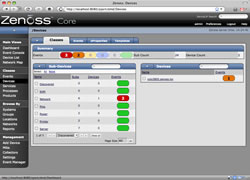Zenoss Core is award-winning Open Source IT monitoring software that offers visibility over the entire IT stack, from network devices to applications. Features include automatic discovery, inventory via CMDB, availability monitoring, easy-to-read performance graphs, sophisticated alerting, an easy-to-use web portal, and much, much more.
Features
Application, Network and Systems Monitoring and Management
Alerting and Automatic Remediation
System Log Monitoring and Event Management
Automated Inventory Discovery and Change Tracking
Data Collection via SNMP, SSH, WMI, JMX and Syslog
200+ Community Extensions (ZenPacks)
Virtual and Cloud Infrastructure Monitoring and Management
Reporting
Alerting via Email and SNMP
Integration with Configuration Management Tools
VMware ESX monitoring
Supported Operating Systems
Red Hat Enterprise Linux 64-bit 6.x (recommended) or 5.x
CentOS 64-bit 6.x (recommended) or 5.x
with SNMP- or SSH-enabled device.
The simplest way to install Zenoss Core 4.2 on a newly-deployed RHEL/CentOS 64-bit 5/6 system is to use our auto-deploy script, which downloads all required files for you.
Register and download
http://community.zenoss.org/community/download
# wget –no-check-certificate https://github.com/zenoss/core-autodeploy/tarball/4.2.4 -O auto.tar.gz
# tar xvf auto.tar.gz
# cd zenoss-core-autodeploy-*
Now, you have the option of editing zenpack_actions.txt, which defines all ZenPacks that will be installed by default (all Core ZenPacks). If you would like to avoid installing certain ZenPacks, then remove the corresponding lines from this file and save it.
# ./core-autodeploy.sh
As part of the install process, your Zenoss installation will be secured, and you will be asked if you would like to set a secure root password for MySQL. It is strongly recommended that you do so.
The auto-deploy script will automatically download and install all required dependencies, as well as Zenoss Core 4.2. After the script completes successfully, use your favorite Web browser and head to port 8080 of your new server (for example, http://127.0.0.1:8080), and then set the Zenoss administrator password and create your initial user account using the Web interface.
Manual Installation
The Installation Guide will guide you through the process of installing Zenoss Core 4.2 on a 64-bit version of Red Hat Enterprise Linux 5.x or 6.x, using RPMs that you download from SourceForge
Download RPMs for Installation, from SourceForge:
RHEL/CentOS 6 64-bit: Zenoss Core RPM (includes Core ZenPacks)
RHEL/CentOS 5 64-bit: Zenoss Core RPM (includes Core ZenPacks)

